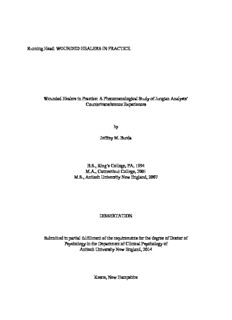
Wounded Healers in Practice: A Phenomenological Study of Jungian Analysts ... PDF
Preview Wounded Healers in Practice: A Phenomenological Study of Jungian Analysts ...
Running Head: WOUNDED HEALERS IN PRACTICE Wounded Healers in Practice: A Phenomenological Study of Jungian Analysts’ Countertransference Experiences by Jeffrey M. Burda B.S., King’s College, PA, 1994 M.A., Connecticut College, 2001 M.S., Antioch University New England, 2007 DISSERTATION Submitted in partial fulfillment of the requirements for the degree of Doctor of Psychology in the Department of Clinical Psychology of Antioch University New England, 2014 Keene, New Hampshire WOUNDED HEALERS IN PRACTICE ii DISDSEepRaTrtAmTenIOt oNf CClOinMicaMl PIsTyTchEoElo PgyA GE The undersigned have examined the dissertation entitled: WOUNDED HEALERS IN PRACTICE: A PHENOMENOLOGICAL STUDY OF JUNGIAN ANALYSTS’ COUNTERTRANSFERENCE EXPERIENCES presented on July 3, 2014 Jeffrey bMy. Burda Candidate for the degree of Doctor of Psychology and hereby certify that it is accepted*. Dissertation Committee Chairperson: James Fauth, PhD Dissertation Committee members: Lorraine Mangione, PhD Lynn Catlin, PhD Accepted by the Department of Clinical Psychology Chairperson Kathi A. 7B/o3rd/1en4, PhD * on Signatures are on file with the Registrar’s Office at Antioch University New England. WOUNDED HEALERS IN PRACTICE iii Acknowledgements I would like to express my gratitude for a number of people whose help, encouragement, and support over the years has allowed this project to come to fruition. My dissertation and student advisor, Jim Fauth, has helped me to become a much better writer and critical thinker—indispensable qualities for my future career as a psychologist. Throughout the ups and downs of this project, Jim’s unwavering guidance has helped me to stay the course when discouraged and to come back when I went too far afield. I thank Lorraine Mangione for her enthusiasm about this project and her ability to always offer fresh and unique perspectives on timeworn ideas. During my time at Antioch, it was comforting to know that I could always talk with Lorraine about anything “outside the box,” and she would understand. I also thank Lynn Catlin for agreeing to come on this journey with me. Lynn’s expertise in and passion for Jungian work was essential in helping to shape the project in directions I wanted to go and to move the project in directions it needed to go. I thank my Antioch colleagues Ted Austin and Ray Feller for their friendship and humor—specifically, Ted for his direct assistance on this project, and Ray for not being (too) sore about losing the job to Ted. I thank my friend Ron Strong who did nothing less than show me the path, again. I would also like to thank all of the participants who supported this project by generously offering me glimpses into their analytic work and for courageously sharing their experiences. Above all, I thank my wife, Sarah, and my son, Henry. Henry, for showing me that it is always more important to play, and Sarah, for sharing the woundedness on our paths, and for ever-reminding me that the healer is, and always has been, within. WOUNDED HEALERS IN PRACTICE iv Table of Contents Acknowledgments………………………………………………...……………………………...iii List of Tables………..…….…………………………………...………………...……….........x Abstract……………………………………………………………………………………………1 Introduction……………………………………………………………………………..…………2 Jung and Countertransference………………………………………………………………….2 Jungians and Countertransference……………………………………………………………..3 Research……………………………………………………………………………….……4 Non-Jungian Contributions…………………………………………………………………….6 Rationale for Present Study……………………………………………………………………7 The Current Project…………………………………………………………………….………9 Literature Review…………………………………………………………………...……………10 Defining the Phenomenon of Countertransference……………………………………...……10 Unique Contributions of Jungian Psychology…………………………………………..……12 Individuation………………………………………………………………………………12 The Jungian Unconscious………………………………………………………..………..12 The Archetypes……………………………………………………………….………..13 Self……………………………………………………………………………………..13 Complex……………………………………………………………………..…………13 Shadow………………………………………………………………………..………..13 Jungian Countertransference Theory…………………………………………………………14 The Analyst’s Personality…………………………………………………………………14 WOUNDED HEALERS IN PRACTICE v Analyst-as-Wounded-Healer…………………………………………………...………14 Analyst Receptivity…………………………………………………………………….17 Analyst Restraint……………………………………………………………….………20 Analyst Mental Health…………………………………………………………………21 Dangers of Countertransference Work…………………………………………….…………21 Over-Identification…………………………………………………………….…………..22 Disengagement or Withdrawal……………………………………………………………23 Intrusion of the Analyst’s Psyche……………………………………………..…………..23 Breaking the Frame…………………………………………….………………………24 Imposing Needs and Strivings……………………………………………...………….24 Desire for Personal Help……………………………………………….………………25 Summary of Jungian Countertransference Theory……………………………………….…..25 Empirical Research…………………………………………………………………..……….26 Jungian Research………………………………………………………………………….26 Dieckmann…………………………………………………………………….……….27 Samuels…………………………………………………………………….…………..29 Catlin……………………………………………………………….…………………..32 Non-Jungian Research……………………………………………………………..…………33 Summary of non-Jungian Research………………………………………….……………34 Critique of non-Jungian Research…………………………………………..………….38 Implications of Extant Research for the Current Study…………………………...………….38 Method……………………………………………………………………………………...……39 Research Design………………………………………………………………...…………….39 WOUNDED HEALERS IN PRACTICE vi Investigator Bias, Credibility, and Reliability………………………………...…………..40 Participants……………………………………………………………………………………42 Eligibility………………………………………………………………………………….42 Sampling…………………………………………………………………………….…….43 Recruitment…………………………………………………………………………...…...43 In-Person Interviews……………………………………………………………..…….44 Telephone Interviews………………………………………………………..…………45 Participant Demographics…………………………………………………………………45 Client Demographics……………………...………………………………………………46 Data Collection…………………………………………………………….…………………46 Semi-Structured Interviews……………………………………………………...………..46 Ensuring Data Accuracy and Credibility…………………………………………..…………47 Member Check……………………………………………………………………...……..47 Second Reader Audit………………………………………………………………..…….47 Data Storage………………………………………………………………………….……….48 Data Analysis…………………………………………………………………………..……..48 Results…………………………………………………………………………………..………..51 Superordinate Themes and Themes……………………….………………………….………51 Participant Examples……………………………………………………………………...51 Main Thematic Findings…………………………………………..……………………...…..54 Countertransference has Origins in Analyst’s Wounds………………………………..……..54 Wounds Rooted in Personal History……………………………………………...……….55 Wounds as Complexes…………………………………………………………………….55 WOUNDED HEALERS IN PRACTICE vii Countertransference Triggers…………………………………………………………..……..55 Client Similarities……………………………………………………...………………….56 Projections from the Client………………………………………………………………..56 Client’s Troublesome Interactive Style……………………………………………...……57 Manifestations of Countertransference……………………………………………………….57 Analyst’s Full Engagement with Client is Disrupted……………………………..………58 Analyst Wishes to Care for the Client……………………………………………….……58 Analyst is Drawn into Spiritual Experience………………………………….……………59 Countertransference Effects……………………………………………………………..……59 Negative Effects on Analytic Process/Outcome…………………………………..………60 Strengthened or Weakened the Analyst-Client Bond………………………………..……60 Analyst Gained Confidence in Handling Countertransference…………………..………..62 Mutual Healing and Transformation……………………………………………...……….63 Countertransference Management……………………………………………………...…….64 In-Session Modulation with Awareness and Understanding……………………….……..64 Analyst Works on Personal Self throughout Analysis…………………………………….65 Modifying/Adapting the Analytic Frame………………………………………….………65 Contextual Factors in Analysis……………………………………………………….………66 Time Factors of Considerations…………………………………………………….……..66 The Unconscious or Some Other Transcendent Power……………………………..…….67 Cultural Factors………………………………………………………………………..…..68 Discussion………………………………………………………………………………………..70 Connections between Study Results and Extant Literature…………………………………..70 WOUNDED HEALERS IN PRACTICE viii Countertransference Originates from Analyst’s Wounds…………………………...…….71 Triggers……………………………………………………………………….………..72 Countertransference Manifests as Analyst Disengagement……………………...………..73 Countertransference is Managed with Attention and Understanding………………….….75 Other Methods of Managing Countertransference…………………………………...…...75 Countertransference Effects on Process/Outcome……………………………….………..77 Positive Client Characteristics…………………………………………………...………..77 Countertransference Impacts the Therapeutic Relationship………………………………77 Contextual Factors in Analysis………………………………………………………..…..78 Time……………………………………………………………………………...…….78 Cultural…………………………………………………………………...……………79 Spiritual…………………………………………………………………...……...…….79 Personal Biases and Reflections……………………………………………...………………80 Study Limitations………………………………………………………………….………….82 Clinical Implications……………………………………………………………...…………..83 Directions for Future Research………………………………………………………….……85 References…………………………………………………………………………………..……86 Appendixes…………………………………………………..…………………………………105 Appendix A. Participant Recruitment Announcement……………… …………………….105 Appendix B. Semi-Structured Interview Protocol…………………………………..………106 Appendix C. Demographic Questionnaire……………………………………………….….108 Appendix D. Client Information Questionnaire………………………………………….….109 Appendix E. Consent Form…………………………………………………………….……110 WOUNDED HEALERS IN PRACTICE ix Appendix F. Post-Interview Thank You/Reminder Letter………………………………….112 Appendix G. Table 1: Superordinate Themes and Themes from Analysis…………………113 WOUNDED HEALERS IN PRACTICE x List of Tables Table 1. Superordinate Themes and Themes from Analysis…………………………...……113
Description: